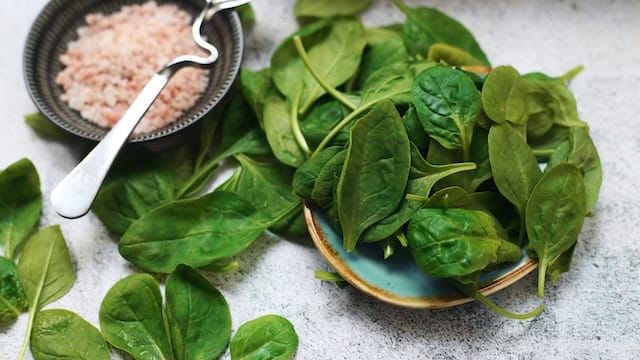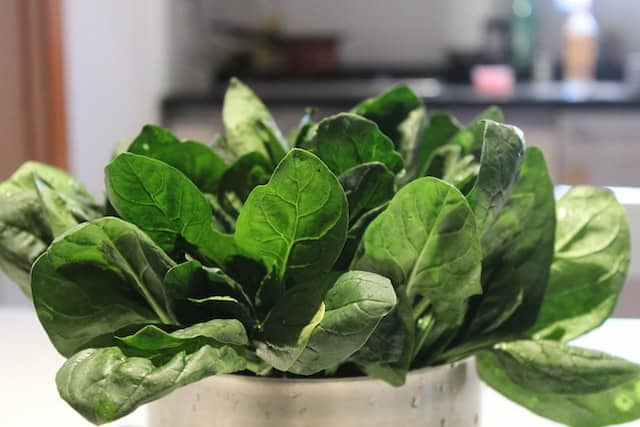Introduction – Climbing Spinach, A Hot Climate Plant
Did you know that Malabar spinach is delicious and extremely nutritious? This vegetable grows best in hot weather and goes by a few other names, such as Ceylon spinach, red vine spinach, or climbing spinach. The plant is highly valued for its health benefits, and because of that, it has grown across the globe. So, is Malabar spinach slimy?

Malabar spinach grows in a vining manner and can be trained to climb up a trellis or grow along the ground. It is known as a heat-loving green, as it prefers warmer temperatures compared to other spinach varieties. The leaves are usually quite large, reaching lengths of over two feet. This makes it easy to identify Malabar spinach among other plants.
One of the most interesting things about Malabar spinach is that its leaves taste extremely similar to fruit rather than vegetables! They have a mild banana-like sweetness and an extra juicy flavor, which makes them so delectable! Malabar spinach is also a rich source of many important nutrients like protein, fiber, vitamins A and C, calcium, and antioxidants.
Where It Malabar Spinach Most Popular
These are the parts of the world where it’s most popular.
- India: In India, Malabar spinach is called ‘Pui Shak’ in Bengali (West Bengal), ‘Poi saag’ in Hindi, and ‘Valchi Bhaji’ or ‘Vaali’ in Konkani (Goa and Konkan region). In the southern parts of India, it’s known as ‘Basale Soppu’ in Kannada and ‘Pasalai Keerai’ in Tamil.
- Southeast Asia: In the Philippines, it’s known as ‘Alugbati’. In Indonesia, it’s called ‘Gendola’, while in Vietnam it’s known as ‘Mồng tơi’.
- China: In Mandarin, it’s referred to as ‘Paederia lanuginosa’ or ‘木耳菜’ which literally translates to ‘wood ear vegetable’ due to its appearance.
- Africa: While there isn’t a specific pan-African name, in various regional languages it may have different names. For example, in Yoruba (spoken in Nigeria), it’s called ‘Amunututu’ which translates to ‘cooling’.
- Brazil: In Portuguese, it’s commonly known as ‘Espinafre indiano’ or ‘Indian spinach’.
- Caribbean: In the Caribbean, it’s often referred to as ‘Calalou’, which can also refer to a popular soup dish in which the leaf is used.
- United States: In the US, it’s mostly known as ‘Malabar spinach’, ‘Ceylon spinach’, ‘Indian spinach’, ‘Vine spinach’, or ‘Climbing spinach’.
Is Malabar Spinach Slimy?
Malabar spinach is a very slimy vegetable, although it doesn’t always feel that way because of its mild flavor. However, the thick leaves of this green are covered in a sticky substance called mucilage which gives them their slippery texture. This substance is thought to have various health benefits and has been used medicinally in China for thousands of years.
Despite the slime factor, Malabar spinach is still a popular vegetable and can be enjoyed in many different ways. You can use it as regular spinach or kale to make delicious salads and sautéed dishes. You can add it to soups or stews for extra nutrients and flavor. Finally, don’t forget about incorporating Malabar spinach into your smoothies! It is especially delicious when paired with berries and other fruits.
How To Cook Malabar Spinach To Avoid Sliminess?
One key to cooking Malabar spinach and avoiding its notorious sliminess is to make sure you properly clean and prepare the leaves before cooking. When rinsing the leaves, use running water instead of soaking them in a tub of water, as this can cause them to release their gel-like substance.
As for cooking, steaming or sautéing are preferred methods over boiling as this can also increase the sliminess. Another tip is to avoid overcooking the leaves, as this will also increase their sliminess. However, some people enjoy the slimy texture, and lightly boiling or microwaving are suitable cooking methods for those individuals. Proper cleaning and cooking techniques can greatly reduce the sliminess of Malabar spinach, creating a delicious and enjoyable dish.
Can Malabar Spinach Be Eaten Raw?
Yes, Malabar spinach can be eaten raw. Although its leaves have a naturally sticky mucilage that gives them a somewhat slimy texture, this substance is harmless to eat and will not cause discomfort or digestive issues if consumed. Mucilage is thought to have many health benefits, including improved digestion, reduced inflammation, and even healing properties for certain skin conditions.
To enjoy Malabar spinach raw in salads or smoothies, you can simply wash and chop the leaves as normal. You can blend whole leaves with other fruits and vegetables in your blender for a delicious green smoothie. Some people also enjoy snacking on raw leafy greens like Malabar spinach straight from the garden. Just wash the leaves well before eating to remove any dirt or insects.
Health Benefits Of Malabar Spinach
Malabar spinach is a nutritious vegetable rich in many important vitamins and minerals. It is a good source of protein, fiber, calcium, and antioxidants, all of which can help support overall health and wellness. In particular, the mucilage contained in Malabar spinach has been shown to improve digestion and reduce inflammation in the body.
This benefits people who are suffering from irritable bowel syndrome or inflammatory bowel disease. Additionally, some studies have found that consuming Malabar spinach may help promote healthy skin by reducing acne and other common skin conditions.
Malabar spinach can be eaten raw, cooked, or pickled. It is a popular vegetable in many Southeast Asian cuisines, where it is often sautéed with garlic and other aromatics or added to soups and stews for extra flavor. You can also use Malabar spinach as regular spinach or kale in salads, smoothies, and other recipes.
If you are looking to reap the health benefits of Malabar spinach, try incorporating it into your diet in one of these delicious ways:
1. Add fresh leaves to salads or sandwiches for an iron-rich boost of nutrients.
2. Sauté chopped stems and leaves with garlic, ginger, and other aromatics for a fragrant and flavorful side dish.
3. Blend chopped leaves with your favorite fruits and vegetables for a delicious green smoothie.
4. Pickle the stems in a tangy vinegar marinade to add crunch and flavor to salads, grain bowls, and other dishes.
5. Use Malabar spinach as regular baby spinach or kale in stir-fries, curries, soups, or stews for an extra nutritional boost.

How Do I Know If Malabar Spinach Has Gone Bad?
Malabar spinach can go bad if not properly stored, so it is important to check for signs of spoilage before consuming the leaves. Some common indicators that Malabar spinach has gone bad include discoloration, even more sliminess, and a strong or unpleasant odor. Additionally, you may notice signs of mold growth on the leaves or stems, which can indicate bacterial contamination. If any of these symptoms are present in your Malabar spinach, it is best to discard it immediately to avoid foodborne illness.
To prevent Malabar spinach from going bad in the future, you should store it in a cool, dry place away from direct sunlight or heat sources. Most vegetable storage containers will work well for storing Malabar spinach as long as there is sufficient airflow and the leaves are kept from moisture. Additionally, you should always ensure that your Malabar spinach has been properly cleaned before storage, which will help prevent bacterial contamination and spoilage.
If you want to keep your Malabar spinach fresh for longer, consider blanching it briefly in hot water before refrigerating or freezing it. This will not only help prevent spoilage, but it can also make the leaves more tender and flavorful when cooked later.
Summary
Overall, whether you are looking for a healthy and unique vegetable to add to your diet or want a tasty new way to incorporate more greens into your meals, Malabar spinach is worth trying! Not only is it delicious, but it is also packed with important nutrients that can help support optimal health and wellness. So why not give Malabar spinach a try today? You certainly won’t be disappointed!
